We may not have the course you’re looking for. If you enquire or give us a call on +43 720 115337 and speak to our training experts, we may still be able to help with your training requirements.
Training Outcomes Within Your Budget!
We ensure quality, budget-alignment, and timely delivery by our expert instructors.
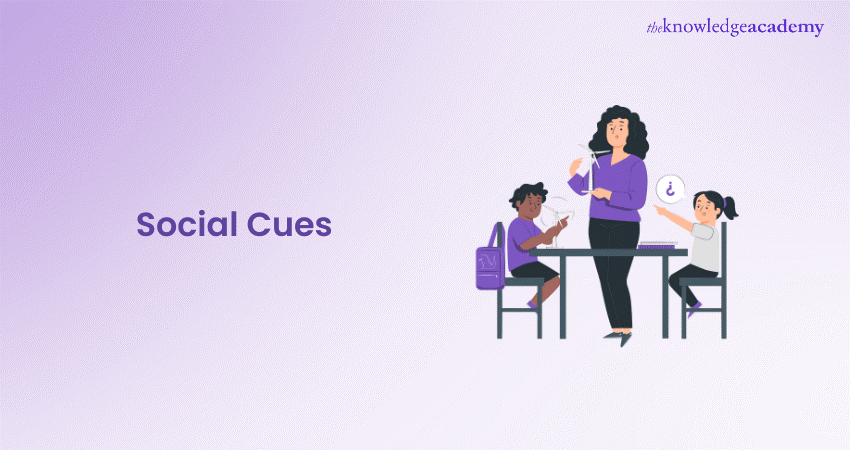
Ever wondered why some conversations flow effortlessly while others feel awkward or strained? The secret often lies in our ability to read and respond to Social Cues. These subtle, nonverbal signals—like body language, tone of voice, and facial expressions—can make or break our interactions, yet they’re frequently overlooked. Understanding Social Cues is crucial for effective communication, helping you navigate social situations with ease and confidence.
In this blog, we’ll explore the different types of Social Cues, from physical gestures to vocal tones, and provide practical examples to enhance your awareness and interpretation skills. Whether you’re aiming to improve personal relationships or succeed in professional settings, mastering Social Cues is your key to more meaningful connections and smoother conversations.
Table of Contents
1) What are Social Cues?
2) Importance of Interpreting Social Cues in a Conversation
3) Physical Social Cues
4) Vocal Social Cues
5) Nonverbal Social Cues
6) Facial Social Cues
7) Conclusion
What are Social Cues?
Social Cues are the subtle signals we use to communicate our thoughts, feelings, and intentions without explicitly stating them. These cues are an essential part of human interaction, helping us understand and respond to the unspoken aspects of communication. They can be conveyed through body language, facial expressions, tone of voice, and even silence. Understanding and interpreting Social Cues allows us to navigate conversations and social interactions more effectively, fostering better relationships and smoother communication.
Whether it’s a slight change in someone’s tone of voice or a fleeting expression on their face, Social Cues offer valuable insights into what a person is truly thinking or feeling. These signals help us gauge the emotional climate of a conversation, adjust our behavior accordingly, and avoid misunderstandings. Without the ability to read Social Cues, interactions can become awkward, strained, or even hostile, making it difficult to connect with others.
Importance of Interpreting Social Cues in a Conversation
Interpreting Social Cues accurately is crucial for successful communication and social interaction. Social Cues provide context that words alone cannot convey. For instance, a person might say they are “fine,” but their body language or tone of voice might suggest otherwise. By picking up on these cues, you can respond more empathetically and appropriately.
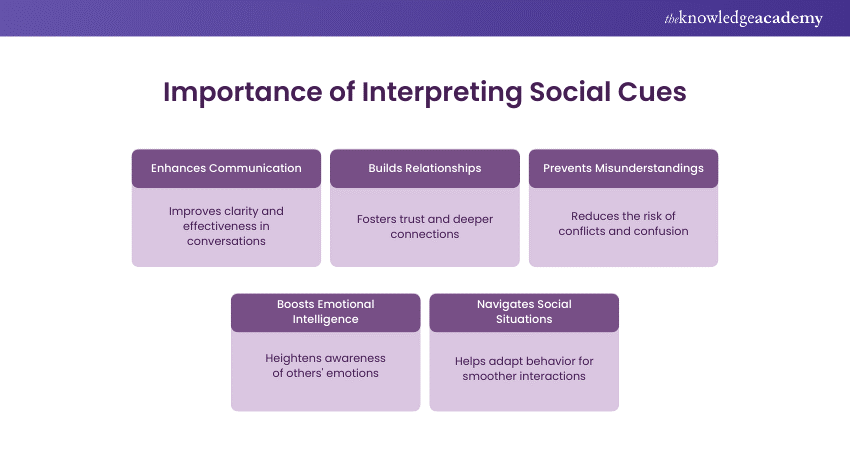
Understanding Social Cues also helps in avoiding miscommunication. In any conversation, there’s a lot more being communicated than just words. The speaker’s posture, facial expressions, and tone all contribute to the message being conveyed. If these cues are misinterpreted, it can lead to confusion or conflict. For example, if someone is being sarcastic but you take their words literally, you might misunderstand their intent.
Moreover, interpreting Social Cues can enhance your Emotional Intelligence. Emotional intelligence involves being aware of your own emotions and those of others. By tuning into Social Cues, you become more attuned to the feelings and needs of others, which can strengthen your relationships both personally and professionally. Whether in a casual chat or a formal meeting, reading Social Cues allows you to navigate the interaction with greater ease and effectiveness.
Learn the art of impactful speaking with our Communication Skills Course – join us and see the difference!
Physical (Body Language) Social Cues
Body language is a powerful form of communication that often speaks louder than words. Physical Social Cues, such as gestures, posture, and movement, provide valuable information about a person’s feelings and intentions. Here, we’ll explore some key physical Social Cues and their meanings.
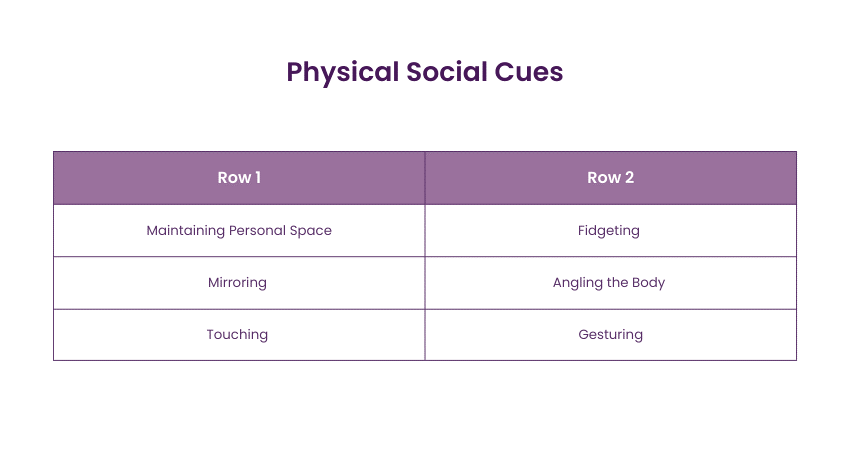
1) Maintaining Personal Space
Personal space, or the physical distance we maintain from others, is a significant Social Cue. The amount of space someone needs varies depending on the relationship and cultural context. Invading someone’s personal space can make them feel uncomfortable or threatened, signaling aggression or a lack of respect. On the other hand, maintaining a comfortable distance can foster a sense of safety and respect.
In conversation, respecting personal space shows that you are attuned to the other person’s comfort level. For example, stepping too close to someone you’ve just met may come off as intrusive, whereas maintaining an appropriate distance indicates politeness and consideration. Personal space also varies depending on the setting—what might be acceptable in a crowded subway could be inappropriate in a one-on-one conversation.
2) Mirroring
Mirroring refers to the subconscious imitation of another person’s gestures, posture, or facial expressions. It’s a physical Social Cue that indicates rapport and connection. When people are comfortable and engaged in a conversation, they often begin to mirror each other’s body language without realising it. This synchrony fosters a sense of trust and mutual understanding.
Mirroring can also be used intentionally to build rapport. By subtly matching the other person’s body language, you can create a sense of empathy and understanding. For example, if someone leans forward during a discussion, you might do the same to signal that you are equally engaged. However, it’s important to do this naturally- overdoing it can come across as insincere or manipulative.
3) Touching
Touch is a powerful physical Social Cue that can convey a wide range of emotions, from comfort and affection to dominance and aggression. The context and nature of the touch are crucial in determining its meaning. A gentle pat on the back can be a sign of encouragement, while a firm handshake might indicate confidence.
In many cultures, touch is used to express warmth and connection. A hug, for instance, can convey support or affection. However, touch is also highly context-dependent and can be misinterpreted if not used appropriately. For instance, touching someone in a professional setting might be seen as inappropriate or invasive, while the same touch in a personal context might be comforting.
4) Fidgeting
Fidgeting, such as tapping fingers or shifting in your seat, is a physical Social Cue that often indicates nervousness, impatience, or discomfort. While it might seem like a small, insignificant action, fidgeting can reveal a lot about someone’s emotional state.
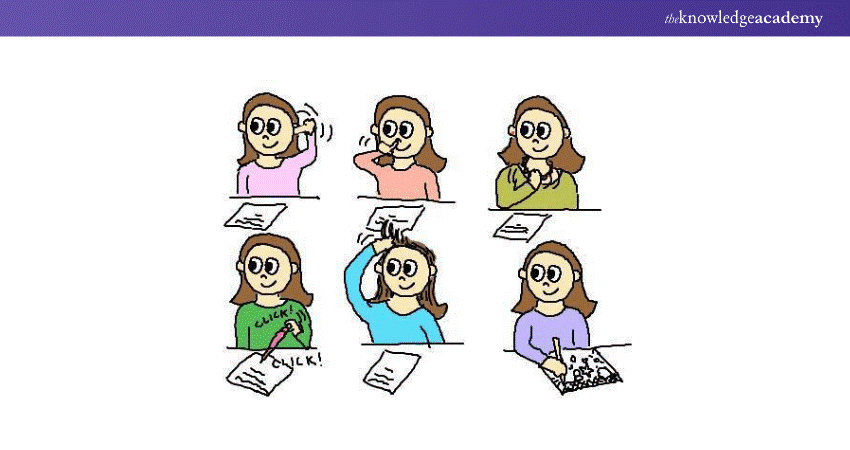
In a conversation, noticing someone’s fidgeting can prompt you to adjust your approach. If someone seems uncomfortable, you might want to change the subject, give them more space, or find a way to ease the tension. Conversely, being aware of your own fidgeting can help you manage how others perceive you, particularly in professional or formal settings.
5) Angling the Body
The way someone angles their body during a conversation can signal their level of interest and engagement. Facing someone directly usually indicates that you are fully engaged and interested in the conversation. On the other hand, angling your body away from someone can suggest disinterest, discomfort, or a desire to leave the interaction.
Subtle changes in body angle can also indicate shifts in the dynamics of a conversation. For example, if someone starts to angle their body away, it might be a sign that they are ready to end the conversation. Being aware of these cues allows you to better navigate social interactions, ensuring that you respond appropriately to the other person’s level of engagement.
6) Gesturing
Gestures, such as hand movements or nodding, are integral to communication and can significantly enhance the clarity of your message. Gestures can emphasise important points, express emotions, and convey enthusiasm or frustration. For example, open hand gestures often indicate openness and honesty, while crossed arms can signal defensiveness or discomfort.
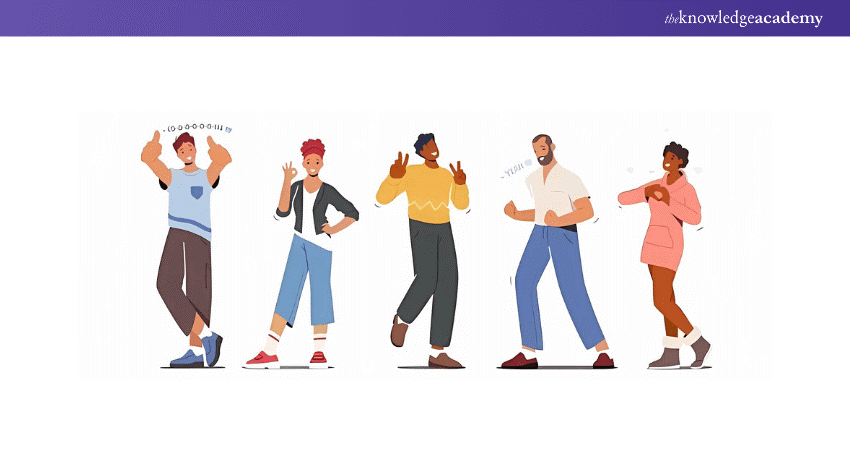
Interpreting gestures in others can provide insights into their emotional state or level of agreement. For instance, nodding usually signifies agreement or understanding, while a lack of gesturing might indicate that someone is disengaged or uninterested. Being mindful of your own gestures can also help you communicate more effectively and make a positive impression.
Turn conflict into collaboration by signing up for our Conflict Resolution and Negotiation for Change Training – book your spot now!
Vocal Social Cues
Vocal Social Cues are the aspects of speech that go beyond the words themselves, including tone, pitch, and silence. These cues can dramatically alter the meaning of what is being said and provide insight into a speaker’s emotions and intentions.
Silence
Silence can be a powerful vocal Social Cue. While it may seem like nothing is being communicated, silence can speak volumes. It can signal discomfort, hesitation, agreement, or even defiance, depending on the context. For example, a pause before answering a question might indicate that the person is carefully considering their response, while an extended silence could suggest disagreement or disapproval.
In conversations, being comfortable with silence is important. It allows space for reflection and can prevent the conversation from feeling rushed. However, it’s also essential to be aware of how the other person might interpret silence—what is a thoughtful pause to one person might feel like awkwardness or disinterest to another.
Tone of Voice
The tone of voice is perhaps one of the most significant vocal Social Cues. It can convey emotions such as happiness, anger, sarcasm, or sadness, often overriding the literal meaning of the words being spoken. For example, saying “I’m fine” in a cheerful tone conveys a very different message than saying the same words in a flat or irritated tone.
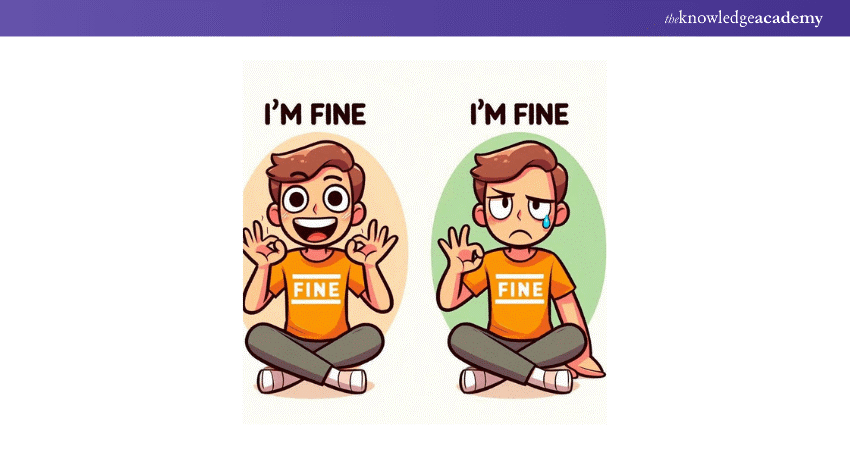
Interpreting tone of voice requires paying attention to subtle variations in pitch, volume, and speed. These variations can provide clues about the speaker’s emotional state or level of engagement. For example, a higher pitch might indicate excitement or anxiety, while a lower pitch might suggest seriousness or authority. Being attuned to these nuances can help you respond more appropriately in conversations, ensuring that you pick up on the underlying emotions and intentions.
Nonverbal Social Cues
Nonverbal Social Cues encompass a wide range of signals, including body language, clothing choices, and personal space. These cues often convey more about a person’s intentions and feelings than their words alone.
Proxemics
Proxemics refers to the use of space in communication. The distance we maintain from others can convey a range of Social Cues, from intimacy to formality. For example, standing close to someone might indicate familiarity or affection, while maintaining a larger distance might signal formality or discomfort.
Understanding proxemics is crucial in various social settings. In professional environments, respecting personal space is often important to maintain boundaries and professionalism. In more casual settings, being aware of how close you stand to someone can help you communicate warmth or establish rapport. Cultural differences also play a significant role in proxemics, as personal space preferences can vary widely across different societies.
Clothing
Clothing is a nonverbal Social Cue that communicates a lot about a person’s identity, social status, and even mood. What we wear can influence how others perceive us and how we perceive ourselves. For example, formal attire in a business setting conveys professionalism and authority, while casual clothing might suggest a more relaxed and approachable demeanor.
Interpreting clothing as a Social Cue involves paying attention to context and the message being conveyed. In a job interview, for instance, dressing appropriately can signal that you take the opportunity seriously. Conversely, in a casual social setting, wearing overly formal attire might create a sense of distance or discomfort. Understanding these cues can help you navigate social interactions more effectively and present yourself in a way that aligns with your intentions.
Master the art of nonverbal communication with our Nonverbal Communication Training – Join today!
Facial Social Cues
Facial expressions are some of the most powerful Social Cues, as they often reveal our true emotions, even when we try to hide them. Our face can express a wide range of emotions, from happiness and surprise to anger and sadness. Understanding facial Social Cues can greatly enhance your ability to connect with others and respond to their emotional states.
Sighing or Yawning
Sighing or yawning can be important facial Social Cues that indicate boredom, fatigue, or frustration. While a sigh might suggest relief or resignation, it can also be a sign of impatience or displeasure. Yawning, on the other hand, is often associated with tiredness, but it can also indicate a lack of interest or engagement in the conversation.
Being aware of these cues in others can help you adjust your approach. If someone sighs frequently during a discussion, it might be a sign that they are feeling overwhelmed or disengaged, prompting you to change the topic or wrap up the conversation. Conversely, being mindful of your own sighing or yawning can help you avoid sending unintended messages.
The Eyes
The eyes are often referred to as the “windows to the soul,” and for a good reason. Eye contact, or the lack thereof, is a powerful Social Cue that can convey confidence, honesty, attentiveness, or discomfort. Maintaining eye contact typically indicates that you are engaged and interested in the conversation, while avoiding eye contact might suggest shyness, guilt, or disinterest.
The direction of someone’s gaze can also provide clues about their thoughts or feelings. For example, looking away or down might indicate discomfort or uncertainty, while looking directly at someone often signals confidence and sincerity. Understanding these cues can help you gauge the other person’s emotional state and adjust your communication style accordingly.
The Mouth
The mouth can express a range of emotions, from happiness and surprise to anger and disgust. A smile, for instance, is a universal sign of friendliness and approachability, while a frown might indicate displeasure or concern. Even subtle changes in the mouth, such as a twitch or pursed lips, can provide insights into a person’s emotional state.
Interpreting mouth-related cues requires attention to context and the overall facial expression. A smile might be genuine or forced, depending on the situation, and understanding the difference can help you respond more appropriately. For example, a forced smile in a tense situation might indicate that the person is trying to mask their true feelings, prompting you to approach the conversation with greater sensitivity.
Conclusion
Social Cues are the unsung heroes of human communication, providing the unspoken context that words alone cannot convey. From body language and tone of voice to facial expressions and clothing choices, these subtle signals play a crucial role in how we interact with others. By understanding and interpreting Social Cues, we can navigate conversations more effectively, build stronger relationships, and avoid misunderstandings.
Transform your communication style with our Assertiveness Skills Training – register today and effectively advocate for yourself!
Frequently Asked Questions

Perception of Social Cues involves recognising and interpreting nonverbal signals such as facial expressions, body language, and tone of voice, which help us understand others' emotions, intentions, and the social context during interactions.

The theory of lack of Social Cues suggests that when these cues are absent, communication can become ambiguous, leading to misunderstandings or misinterpretations, particularly in digital communication where nonverbal signals are limited.

The prefrontal cortex and amygdala control Social Cues. The prefrontal cortex processes and interprets these cues, while the amygdala is involved in emotional responses, crucial for understanding social interactions.

The Knowledge Academy takes global learning to new heights, offering over 30,000 online courses across 490+ locations in 220 countries. This expansive reach ensures accessibility and convenience for learners worldwide.
Alongside our diverse Online Course Catalogue, encompassing 17 major categories, we go the extra mile by providing a plethora of free educational Online Resources like News updates, Blogs, videos, webinars, and interview questions. Tailoring learning experiences further, professionals can maximise value with customisable Course Bundles of TKA.

The Knowledge Academy’s Knowledge Pass, a prepaid voucher, adds another layer of flexibility, allowing course bookings over a 12-month period. Join us on a journey where education knows no bounds.

The Knowledge Academy offers various Communication Skills Courses, including the Assertiveness Skills Training, Interpersonal skills Training, and Visual Communication Course. These courses cater to different skill levels, providing comprehensive insights into Assertion and Reason.
Our Business Skills Blogs cover a range of topics related to Communication skills, offering valuable resources, best practices, and industry insights. Whether you are a beginner or looking to advance your Business skills, The Knowledge Academy's diverse courses and informative blogs have got you covered.
Upcoming Business Skills Resources Batches & Dates
Date
 Interpersonal Skills Training Course
Interpersonal Skills Training Course
Fri 21st Feb 2025
Fri 25th Apr 2025
Fri 20th Jun 2025
Fri 22nd Aug 2025
Fri 17th Oct 2025
Fri 19th Dec 2025







 Top Rated Course
Top Rated Course



 If you wish to make any changes to your course, please
If you wish to make any changes to your course, please


